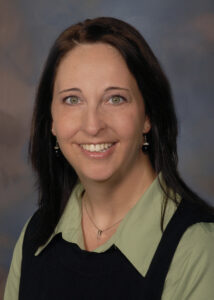 The upcoming 2023 Nurse Practitioner Week, Nov. 12–18, was good reason for Debbie Durkee, RN, MSN, FNP-C, to reflect on the profession and its growth, her years in practice, and the importance of active participation in the ARP.
The upcoming 2023 Nurse Practitioner Week, Nov. 12–18, was good reason for Debbie Durkee, RN, MSN, FNP-C, to reflect on the profession and its growth, her years in practice, and the importance of active participation in the ARP.
Unlike many who go into the field, Ms. Durkee never felt drawn to nursing as a child, or even as a young adult, but she is glad her life pushed her in that direction. “While my mom and grandma were both nurses, I had not thought about it as a career. I just kind of fell into nursing and, later, into becoming a nurse practitioner,” she says.
After completing a family nurse practitioner program and certification, she began working in pediatric rheumatology, where she developed the specialized knowledge and skills needed to manage rheumatic diseases.
“Even though a lot of people think that working in pediatric rheumatology would be hard and sad, in reality it’s great because kids are typically happy, resilient and easy to work with,” Ms. Durkee says. “It is so rewarding to be able to teach kids and their families what is going on, to help them feel better and navigate the healthcare system, and then also to teach the kids how to be the expert on their disease so they can advocate for themselves. I love working in pediatric rheumatology.”
Growth of the Field
The NP profession has evolved over its 50-plus-year history, and as the demand for rheumatic and other healthcare services continues to rise, that evolution will no doubt continue, says Ms. Durkee. “It is the value of NPs that NP Week is highlighting: NPs are equipped to step into clinics that are in need of additional medical professionals, and can improve outcomes and lower healthcare costs while achieving high levels of patient satisfaction.”
The University of Colorado, Denver, offered the first NP program—a certificate offering—in 1965. Just two years later, Boston College established a master’s program for nurse practitioners. Within a decade, dozens of NP programs had sprung up around the country, and more than 15,000 NPs were in practice.1 Today, the number of licensed NPs in the U.S. has topped 355,000, but the need for NPs in primary care, as well in such specialties as rheumatology, remains great.2
According to the American Association of Nurse Practitioners (AANP), “The U.S. is facing a shortage of physicians in all medical specialties, with an estimated shortfall of 34,600 to 82,600 by 2025.”3
With regard to rheumatology specifically, the ACR estimates that by 2030 the U.S. demand will be 8,184 clinicians, but the supply is expected to only be 3,455 clinicians.4
According to the AANP, “as care responsibilities shift, NPs and physician associates will handle the large majority of chronic disease management. This evolution in care delivery offers an important opportunity to evaluate the current chronic disease management delivered by NPs and to develop and evaluate NP education to improve upon that care.”3
A Personal Road

Ms. Durkee
Ms. Durkee’s journey to becoming an NP was a winding one. She first pursued a bachelor’s degree in family and human development, with an emphasis in marriage and family relations, and then a social service worker license in Utah. After spending seven years providing behavior-modification and mental health services to children, and watching what she described as “a decline in access to mental healthcare,” she became interested in pursuing a different direction and shifted toward nursing.
As Ms. Durkee earned her degrees as a licensed practical nurse and then a registered nurse, she began working in a short stay/observation unit at Primary Children’s Hospital, Salt Lake City. “I spent some of my time giving infusions to kids for a variety of conditions, including [rheumatic] diseases,” she says. “I really liked that because I was learning about the medications, interacting with physicians and seeing the kids at very set intervals, which allowed me to provide patient care while also developing relationships with the young patients and their families over time.”
Just as she started to think about options beyond hospital shift work, a friend mentioned nurse practitioner school and right away, she says, “It felt right.”
Typically, students entering NP programs are already practicing RNs, so she was ready on that front. While not all states require a Bachelor of Science in Nursing for admission, Ms. Durkee’s home state of Utah did, so she headed back to college to meet that qualification. Once in the NP program, she went through considerable advanced clinical training. After graduating, she passed a national board exam to finally hold the title of certified nurse practitioner.
With her training complete in 2012, Ms. Durkee accepted an NP position in rheumatology as an employee with the University of Utah, Salt Lake City, working out of the Intermountain Healthcare facilities in Salt Lake City, Riverton and Layton. It was a good fit then and remains a good fit now—more than 10 years later, she says. “We really have a cohesive team. I love what I do, and I feel like I make a difference every single day.”
The longer she has been an NP, the stronger her conviction becomes that NPs serve a unique role in healthcare. “There is a difference between the medical model of learning and practice, and the nursing model,” she says.
A significant focus of the NP profession is on providing education, Ms. Durkee says. “Because we all work on the floor before we go through NP training, we’re very used to doing education as part of the nursing role: teaching about everything from illnesses and medications to hospital admissions and discharge. Now, as an NP in rheumatology, I have come to enjoy that role even more because I’m equipping young patients to understand their conditions and treatments, so they can manage their diseases and overall well-being better.”
She also places an emphasis on mental health. “I spend a lot of time on mental health discussions, especially since the COVID pandemic,” she says. “That is particularly true with teenagers because they’re facing chronic health conditions on top of all of the regular teen issues,” she says.
That support extends to parents: “I also spend time with parents, so they know I’ve got their back and will do everything I can to encourage their child to make healthy choices,” Ms. Durkee says.
Advocacy
Having their back also means going to bat for patients and families through advocacy, Ms. Durkee contends. That may mean urging pharmaceutical companies to develop medications or study dosages for non-adult populations, pushing lagging state governments to give NPs the same
independence and autonomy they have in other states or advocating for patients and their families in any number of other ways. Advocacy is particularly evident in ARP activities and during NP Week, notes Ms. Durkee, who has served on several committees over the years.
“I enjoy being an NP, especially in rheumatology,” says Ms. Durkee. “No two days are alike. I am continually learning about conditions and treatments. I get to develop relationships with my patients and their families. I love my job.”
Leslie Mertz, PhD, is a freelance science journalist based in northern Michigan.
References
- Historical timeline. American Association of Nurse Practitioners. https://www.aanp.org/about/about-the-american-association-of-nurse-practitioners-aanp/historical-timeline.
- NP fact sheet. American Association of Nurse Practitioners. https://www.aanp.org/about/all-about-nps/np-fact-sheet.
- Nurse practitioner rheumatology workforce: Could this be you? American Association of Nurse Practitioners. 2019 Sep 4. https://www.aanp.org/news-feed/nurse-practitioner-rheumatology-workforce-could-this-be-you.
- Battafarano DF, Ditmyer M, Bolster MB, et al. 2015 American College of Rheumatology workforce study: Supply and demand projections of adult rheumatology workforce, 2015–2030. Arthritis Care Res (Hoboken). 2018 Apr;70(4):617–626.
